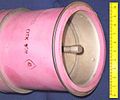Thyratron

Thyratron ( old Greek artificial word, for example gate device ) is the name for a gas-filled tube rectifier with a hot cathode that can be controlled via a grid and is similar in structure to a triode . Mercury vapor , xenon , neon , krypton or hydrogen are used as filling gas .
function
A high voltage is applied between the anode and cathode , which is part of the working circuit. Ignition (= conductivity, not burn-up) of the filling gas can be prevented by applying a sufficiently negative voltage to the control grid . If the grid potential is positive (or the grid is not connected), the filling gas ignites, which causes an arc discharge between the anode and cathode and converts the entire space into a conductive plasma . Depending on the specification, the anode current can then assume a value of a few thousand amperes , and the voltage drop between anode and cathode, the so-called operating voltage, is approx. 10 to 15 V.
The grid is surrounded by an ion coating from the plasma and thus loses its influence on the gas discharge . Even by reducing the grid potential, the arc discharge can no longer be prevented or the anode current can be controlled. The plasma in the thyratron can only be extinguished by reducing the anode voltage below the burning voltage or by interrupting the anode circuit.
If you apply an alternating voltage to the anode circuit and control the grid voltage accordingly, you can control the ignition time of the thyratron within the positive half-sine wave and thus the anode current flowing on average. The thyratron then extinguishes automatically with the negative half-wave and ignites again with the next positive half-wave. This arrangement then works as a phase control , as it is implemented today with thyristors or triacs .
Historical xenon thyratron Type 885 from RCA for timing elements and sawtooth generators
Hydrogen thyratron for radar pulse generator (max. 25 kV / 500 A pulse current, height approx. 30 cm), next to it a small thyratron for timing relay (type 2D21, approx. 60 W).
application
Thyratrons were used to implement controllable rectifiers and phase angle controls until the 1960s . Today they have been almost completely replaced by thyristors , triacs and IGBT .
Hydrogen pulse thyratrons are still manufactured today, however, because they can switch very high powers particularly quickly. They are used in pulse generators, including excimer lasers , to control the pump discharge, and have only been partially replaced by semiconductors there since around 2004.
A special application was the joint construction of several thyratrons in mercury vapor rectifiers .
The musician, composer and designer Oskar Sala used thyratron tubes in his Mixturtrautonium , with which he set many cinema and industrial films to music from 1960.
Related components
Cold cathode thyratron
There are also thyratrons with an unheated cathode, so-called cold cathode thyratrons. These are also known as relay tubes . They contain an inert gas filling and differ from the heated thyratron in their ignition behavior: While a heated thyratron ignites with sufficient voltage between anode and cathode even with a currentless grid or grid voltage zero, the relay tube needs a positive voltage at its ignition electrode (the "starter “): Only when this creates a glow discharge between the ignition electrode and the cathode, this also spreads to the anode and closes the working circuit there. Before this start discharge is ignited, no current flows into the ignition electrode - when switched off, relay tubes have a very high input resistance. The ignition takes place at a certain positive voltage of the ignition electrode. For this reason, and because of their small size, they used to be used in large numbers in timing relays and telephone systems. They indicate their working condition optically through the glow discharge.
Due to the operation in the area of a glow discharge, the anode current is only a few milliamperes, the operating voltage remains at comparatively high values of around 100 volts.
Since relay tubes do not need to be heated, they are immediately ready for use and do not consume any energy before they are ignited. Relay tubes, since they do not have a hot cathode, have a long service life.
Ignitron
Ignitrons work with a mercury pond cathode, require very high ignition currents and can switch continuous outputs in the megawatt range.
Thyristor
The thyristor is a semiconductor component that has similar characteristics to the thyratron.
literature
- Adolf Senner: Electrical engineering. 4th edition. Verlag Europa-Lehrmittel, 1965




